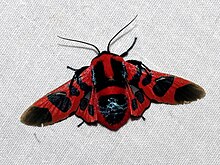| Thyrididae | |
|---|---|

| |
| Arniocera auriguttata | |

| |
| Glanycus coendersi, one of the aposematically coloured day-flying species of Thyrididae | |
| Scientific classification | |
| Domain: | Eukaryota |
| Kingdom: | Animalia |
| Phylum: | Arthropoda |
| Class: | Insecta |
| Order: | Lepidoptera |
| Clade: | Eulepidoptera |
| Clade: | Ditrysia |
| Clade: | Apoditrysia |
| Clade: | Obtectomera |
| Superfamily: | Thyridoidea Herrich-Schäffer, 1846 |
| Family: | Thyrididae Herrich-Schäffer, 1846 |
| Subfamilies | |
| Diversity | |
| Over 1,000 species | |
The Thyrididae comprise the family of picture-winged leaf moths. They are the only family in the superfamily Thyridoidea, which sometimes has been included in the Pyraloidea, but this isn't supported by cladistic analysis.
Most species live in the tropics and subtropics. They are colourful and often day-flying moths.[1] There are four subfamilies. Their biology is little known. Thyridid specimens are rare in museum collections.
Genera[edit]
- Chrysotypus Butler, 1879
- Microctenucha Warren, 1900
Charideinae[edit]
- Amalthocera Boisduval, 1836
- Arniocera Hopffer, 1857
- Byblisia Walker, 1865
- Cicinnocnemis Holland, 1894
- Dilophura Hampson, 1918
- Lamprochrysa Hampson, 1918
- Marmax Rafinesque, 1815
- Netrocera Felder, 1874
- Toosa Walker, 1856
- Trichobaptes Holland, 1894
Siculodinae[edit]
- Belonoptera Herrich-Schäffer, [1858]
- Bupota Whalley, 1971
- Calindoea Walker, 1863
- Cecidothyris Aurivillius, 1910
- Collinsa Whalley, 1964
- Cornuterus Whalley, 1971
- Draconia Hübner, 1820
- Epaena Karsch, 1900
- Gnathodes Whalley, 1971
- Hapana Whalley, 1967
- Hypolamprus Hampson, 1892
- Kalenga Whalley, 1971
- Kuja Whalley, 1971
- Lelymena Karsch, 1900
- Morova Walker, 1865
- Nakawa Whalley, 1971
- Nemea Whalley, 1971
- Opula Walker, 1869
- Pyrinioides Butler, 1881
- Rhodoneura Guenée, 1858
- Siculodes Guenée, 1858
- Symphleps Warren, 1897
- Tridesmodes Warren, 1899
- Zeuzerodes Pagenstecher, 1892
Striglininae[edit]
- Banisia Walker, 1863
- Jamboina Whalley, 1976
- Macrogonia Herrich-Schäffer, 1855
- Mathoris Guenée, 1877
- Monodecus Whalley, 1976
- Mystina Whalley, 1976
- Rhodogonia Warren, 1897
- Speculina Whalley, 1976
- Striglina Guneée, 1877
- Tanyodes Möschler, 1882
- Tristina Whalley, 1976
Thyridinae[edit]
- Dysodia Clemens, 1860 (includes Platythyris)
- Glanycus Walker, 1855
- Pseudothyris Guérin-Méneville, 1832
- Sijua Whalley, 1971
- Thyris Laspeyrés, 1803
References[edit]
- Firefly Encyclopedia of Insects and Spiders, edited by Christopher O'Toole, ISBN 1-55297-612-2, 2002
External links[edit]
- TOL
- ACG Page of images of Thyrididae from Area de Conservación Guanacaste, Costa Rica.
- Hexeris enhydris, seagrape borer on the UF / IFAS Featured Creatures Web site
Well, that’s interesting to know that Psilotum nudum are known as whisk ferns. Psilotum nudum is the commoner species of the two. While the P. flaccidum is a rare species and is found in the tropical islands. Both the species are usually epiphytic in habit and grow upon tree ferns. These species may also be terrestrial and grow in humus or in the crevices of the rocks.
View the detailed Guide of Psilotum nudum: Detailed Study Of Psilotum Nudum (Whisk Fern), Classification, Anatomy, Reproduction